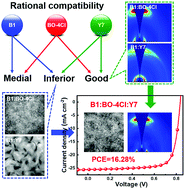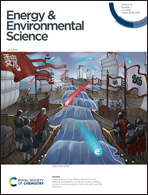Rational compatibility in a ternary matrix enables all-small-molecule organic solar cells with over 16% efficiency†
Abstract
How to manipulate the phase separation and molecular arrangement to meet the need of efficient charge generation and extraction remains a long-standing challenge in all-small-molecule organic solar cells (ASM-OSCs). Herein, a small molecule acceptor Y7 as a morphology modulator was incorporated into a B1:BO-4Cl matrix to fabricate ternary ASM-OSCs. Y7 possesses excellent compatibility with the acceptor BO-4Cl but poor compatibility with the donor B1. The two acceptors prefer to form an alloy-like structure in ternary blends due to their good compatibility, which is conducive to fine-tuning the molecular arrangement for facilitating charge extraction. The inferior compatibility originating from the strong intermolecular interaction between Y7 and B1 can provide a driving force to manipulate the phase separation between the donor and acceptor for gaining well-formed nanofibrous and bi-continuous interpenetrating networks, leading to efficient charge separation, transport and collection in ternary blends. The ternary ASM-OSCs with 10 wt% Y7 in acceptors achieve a top-ranked power conversion efficiency of 16.28% with a holistic improvement of short-circuit current density, open-circuit voltage and fill factor. This work opens a new avenue to optimize the morphology for further boosting the performance of OSCs.

- This article is part of the themed collection: Energy & Environmental Science Recent HOT Articles


 Please wait while we load your content...
Please wait while we load your content...